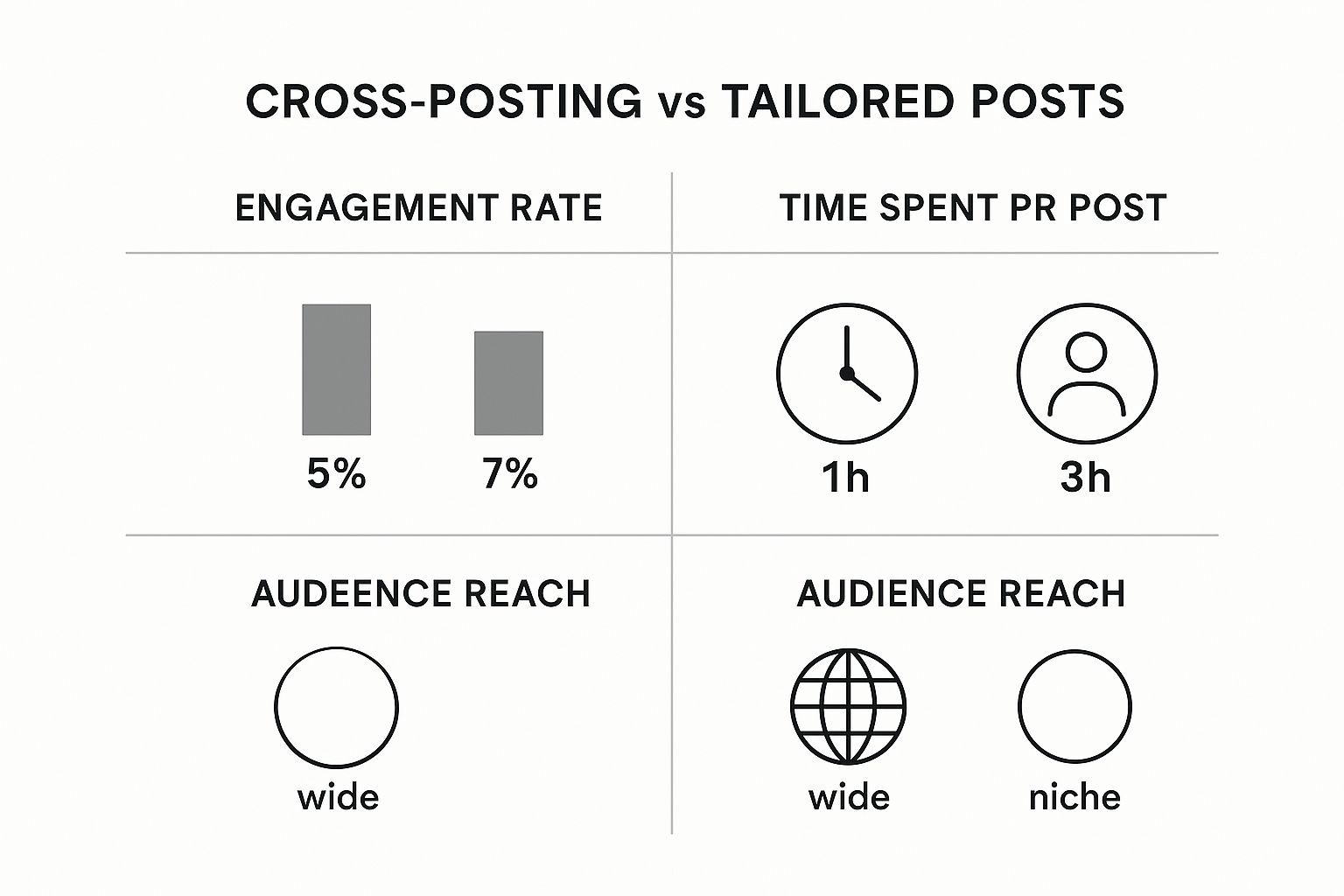
Cross Posting on Social Media: The Complete Strategy Guide
Master cross posting on social media with proven strategies that drive real engagement. Get expert tips from successful brands and marketers.
Why Cross Posting Has Become Essential For Brand Growth
Managing a consistent presence across various social media platforms can feel overwhelming. However, strategic cross posting is no longer a shortcut; it's essential for brand growth and expanding reach. This isn't about mindlessly duplicating content; it's about adapting your message to each platform's unique characteristics. Think of it like tailoring a suit: the core material is the same, but the fit is customized.
Expanding Reach and Maximizing Efficiency
Cross posting lets brands reach a wider audience without drastically increasing their workload. Consider this: over 5.17 billion people use social media globally. Reaching even a small portion requires a strategic approach. Cross posting helps you connect with potential customers on their preferred platforms, maximizing your content's potential.
This streamlined approach frees up valuable time for your team. They can focus on creating engaging content and analyzing its impact, instead of repetitive posting tasks. This strategy is so crucial that social media ad spending is projected to exceed $255 billion by 2028, highlighting the importance of effective social media strategies like cross posting. Discover more insights about cross posting on social media.
From Copy-Paste to Strategic Amplification
Simply duplicating content across platforms is ineffective. Successful cross posting involves understanding each platform's unique characteristics and tailoring your message accordingly. For example, a visual platform like Instagram thrives on high-quality images and short captions, while LinkedIn favors long-form content and professional discussions. Repurposing content requires adjusting the format, tone, and style to resonate with each platform's audience.
Engaging Diverse Audiences and Fostering Growth
Each social media platform attracts a different demographic. This presents both a challenge and an opportunity. By strategically cross posting, you can connect with diverse audiences, each with unique preferences. Maintaining a consistent brand voice while adapting to each platform builds trust and recognition. This multi-platform approach is key for fostering brand growth and establishing a strong social media presence.
Building Sustainable Workflows
The key to successful cross posting is establishing sustainable workflows. This involves leveraging automation tools like ViewPrinter to streamline the process while maintaining authenticity. These tools allow you to schedule posts, track performance, and adapt content, ensuring your message reaches the right audience at the right time on the right platform. This strategic approach prevents burnout and lets your team focus on creating compelling content that drives results, ensuring consistent engagement and amplifying your brand's message across social media.
Finding Your Audience Across The Social Media Landscape

Effective cross-posting on social media starts with understanding your audience and their online habits. Where do they spend their time? How do they interact with content on different platforms? Knowing this is key to tailoring your cross-posting strategy and making it as effective as possible.
Platform-Specific User Behavior
Every social media platform is unique. Each one cultivates its own culture and attracts a particular demographic. Facebook, for example, has a huge user base and serves as a central hub for community engagement and personal updates. LinkedIn, on the other hand, caters to professionals, making it perfect for sharing industry news and career-related content. Instagram, with its visual emphasis, prioritizes aesthetically pleasing content and visual storytelling. Understanding these nuances is essential for effective cross-posting.
User behavior also varies significantly across these platforms. How people engage with content on Facebook is very different from how they interact on LinkedIn or Instagram. Long-form articles might do well on LinkedIn, while visually-driven content tends to get more engagement on Instagram. This means simply copying and pasting the same content across all platforms won't get you the best results.
Social media demographics are crucial for tailoring your strategy. In 2024, platforms like Facebook continued to dominate with over 3 billion monthly active users. Other platforms like YouTube, Instagram, and Snapchat also have large user bases. Understanding these demographics helps you create content that resonates with different segments, especially since users spend varying amounts of time on different platforms. Facebook's large user base makes it suitable for a broad reach, while LinkedIn is best for professional content. Find more detailed statistics here.
Mapping the Customer Journey
Successful cross-posting involves mapping your ideal customer journey across multiple touchpoints. This means understanding how your target audience moves between platforms and what kind of content grabs their attention at each stage. A potential customer might discover your brand through a visually appealing Instagram post, then visit your website to learn more, and finally connect with you on LinkedIn for professional updates.
Prioritizing Platforms for Conversion
Instead of focusing on vanity metrics like likes and followers, prioritize platforms based on their potential for conversion. Figure out which platforms drive the most valuable actions: website visits, lead generation, or sales. By focusing on the platforms with the highest return on investment, your cross-posting strategy will directly contribute to your business goals. Evaluating emerging platforms and their potential for reaching your target audience is also crucial for staying ahead and maximizing your reach. This data-driven approach to cross-posting optimizes your efforts for tangible results.
Creating Content That Connects On Every Platform
Cross-posting on social media can significantly expand your reach. However, simply duplicating the same content across all platforms isn't enough. Savvy marketers know that each platform has a distinct culture and audience. The secret to successful cross-posting? Adapting your core message while keeping a consistent brand voice.
Tailoring Your Message for Each Platform
Think of your core message like a universal remote. It has all the essential functions, but you need to select the right input for each device. Similarly, your core message stays the same, but its presentation needs to be adjusted for each platform. This involves tweaking the format, tone, and style to resonate with each platform's specific audience. You might be interested in: How to master content repurposing.
For example, Instagram, being visually driven, demands eye-catching images and short, impactful captions. On the other hand, LinkedIn, with its professional focus, prefers longer, more in-depth content and discussions. This isn't about reinventing the wheel, it's about reframing your message to suit the platform.
From Mediocre Engagement to Standout Results
Analyzing successful cross-posted content reveals key techniques that boost engagement. Successful brands respect platform etiquette while maintaining consistency. They understand that adjusting visuals, writing platform-specific captions, and strategically timing posts are vital for maximizing impact.
The infographic below visually demonstrates the impact of tailoring posts compared to simply cross-posting them across platforms, examining engagement rate, time spent per post, and audience reach.

As the infographic shows, cross-posting quickly reaches a wider audience. However, tailored posts get much higher engagement and resonate with niche audiences. This indicates that investing time in platform-specific adjustments leads to better results over time.
Engagement Rates and Platform Specificity
Engagement rates also differ significantly across platforms. This difference impacts the effectiveness of cross-posting strategies. As of 2025, Instagram's engagement rate was reported as low as 1.16%, significantly less than other platforms. This emphasizes the importance of customizing content to suit each platform's unique audience and engagement patterns. A post that performs well on Instagram may not have the same impact on LinkedIn, where user engagement is different. Explore this topic further here.
To better illustrate how to adapt content, let's look at a comparison of different platforms:
To help guide content adaptation for various platforms, the following table provides a quick overview of key considerations:
Platform-Specific Content Adaptation Guide Comparison of optimal content formats, character limits, and engagement strategies across major social media platforms
| Platform | Optimal Post Length | Best Visual Format | Peak Engagement Hours | Key Adaptation Strategy | |---|---|---|---|---| | Instagram | Short captions (under 125 characters) | High-quality images and videos | Varies depending on audience | Focus on visuals and storytelling | | LinkedIn | Longer, in-depth posts (up to 1300 characters) | Professional images and videos | Business hours | Share insights and thought leadership | | Twitter | Concise tweets (under 280 characters) | Images, GIFs, and short videos | Varies depending on audience | Engage in conversations and use relevant hashtags |
This table highlights how post length, visual format, and even timing can change depending on the platform. Understanding these nuances allows you to tailor your content effectively.
Maintaining Authenticity and Optimizing for Algorithms
Maintaining authenticity across platforms can be tricky. While adapting your message, it's crucial to stay true to your brand voice and values. This builds trust and reinforces brand recognition. However, respecting each platform's algorithm is also crucial for visibility.
This means understanding how each platform prioritizes content, whether through hashtags, keywords, or engagement metrics. By strategically incorporating these elements, you can ensure your message reaches the right audience while maintaining a genuine brand presence. This combination of authenticity and optimization is the foundation of successful social media cross-posting.
Tools And Automation That Actually Work

Successfully cross-posting on social media hinges on using the right tools. The correct platform can streamline your workflow, while the wrong one can create chaos. Let's explore the key features that separate effective tools from those that waste your time. This careful selection process will help ensure your cross-posting efforts are efficient and contribute to your overall social media success.
Essential Features of Effective Cross-Posting Tools
A good cross-posting tool should simplify your life. It should make managing your social media presence easier, not harder. Here are some essential features to look for:
-
Platform Integration: The tool should seamlessly connect to all your social media platforms. Managing everything from a single dashboard eliminates the constant switching between different apps.
-
Scheduling and Automation: Scheduling posts in advance is crucial for maintaining a consistent online presence. Look for tools with flexible scheduling and automated posting.
-
Content Customization: Simply duplicating content across platforms isn't effective. A good tool lets you customize captions, hashtags, and visuals for each platform, directly within the scheduling interface.
-
Analytics and Reporting: Tracking your cross-posted content's performance is vital. Choose a tool with robust analytics and reporting so you can understand what resonates with your audience and what doesn't.
Building Automated Workflows While Maintaining Authenticity
Automation saves time, but it's crucial to retain a human touch. While scheduling and automated posting are valuable, your content must remain authentic. Your audience wants to connect with a real person.
Striking this balance is the key to long-term engagement. For instance, agency websites that incorporate case studies see 167% higher conversion rates. This highlights the importance of showcasing real results and building trust. Explore this topic further.
Free vs. Paid Options: Assessing the Value
Many free cross-posting tools exist, but they often have limitations. Paid tools usually offer advanced features like detailed analytics, team collaboration, and AI-powered optimization. Consider your needs and budget to determine the best fit. Sometimes, investing in a paid tool saves time and improves results.
Advanced Features: AI and Analytics Integration
Some cross-posting tools offer advanced features like AI-powered optimization and integrated cross-platform analytics. AI can suggest optimal posting times, generate relevant hashtags, and even create content variations for different platforms. This can significantly enhance your cross-posting strategy.
Integrating analytics provides a comprehensive view of your social media performance. This offers valuable insights to refine your approach. Choosing a tool with these integrated functionalities can considerably improve your cross-posting and overall social media management.
Measuring What Matters For Cross Posting Success

Vanity metrics such as likes and shares can be alluring. However, real cross-posting success hinges on understanding the metrics that genuinely affect your results. This involves going beyond superficial engagement numbers and diving into the key performance indicators (KPIs) that offer actionable insights. Let's explore how to optimize your strategy for tangible results.
Setting Up Actionable Analytics Dashboards
Effective analytics dashboards transform raw data into usable intelligence. Don't get lost in a sea of numbers. Instead, concentrate on metrics aligned with your goals. Are you focused on driving website traffic, generating leads, or boosting brand awareness?
Knowing your core objectives is crucial for dashboard setup. For example, if lead generation is your goal, prioritize metrics like click-through rates on post links and subsequent website conversions. This focused approach directly correlates cross-posting efforts with business outcomes. Further, segmenting data by platform helps you identify the most effective channels for lead generation.
Tracking Content Performance Across Platforms
Tracking content performance across platforms isn't just a technical task; it's about understanding your audience's behavior. Analyze how the same content performs on different platforms. A long-form article might excel on LinkedIn but struggle on Instagram, while an infographic could shine on Pinterest but not on Twitter.
Therefore, analyzing platform-specific engagement is vital. By recognizing these patterns, you can anticipate which content types suit each platform. This leads to more strategic content creation and maximizes your chances of cross-posting success. Learn more in our article about how to measure social media ROI.
A/B Testing and ROI Measurement
A/B testing is crucial for refining your cross-posting strategy. Experiment with different content variations, like headlines, visuals, or calls to action. This helps you identify what resonates best with your audience on each platform. A data-driven approach continually optimizes your content for improved engagement and conversions.
But engagement is only part of the story. Measuring true ROI requires connecting cross-posting to business outcomes. How many leads did your cross-posted content generate? How many converted into customers? Tracking these metrics demonstrates the value of your strategy and justifies continued investment.
Frameworks for Monthly Performance Reviews
Monthly performance reviews are essential for ongoing improvement. They provide a regular opportunity to evaluate your cross-posting strategy's effectiveness. Utilize a structured framework to guide these reviews, ensuring comprehensive coverage.
The following table, "Cross Posting Performance Metrics Dashboard," provides essential KPIs to track for measuring cross-posting success:
| Metric | Primary Platforms | Benchmark Range | Optimization Focus | Frequency of Review | |-----------------------------|-------------------|-----------------|---------------------------|----------------------| | Engagement Rate | All | 1-5% | Content quality, timing | Monthly | | Click-Through Rate (CTR) | All | 0.5-2% | Call to action, link placement | Monthly | | Conversion Rate | All | Varies | Landing page optimization | Monthly | | Reach | All | Varies | Targeting, hashtag strategy | Monthly | | Website Traffic from Social | All | Varies | Content relevance | Monthly |
This table highlights the importance of consistently reviewing key metrics across platforms. By tracking these numbers, you can pinpoint improvement areas and ensure your strategy aligns with your overall business objectives. This structured approach sets the stage for continued growth and success.
Avoiding The Mistakes That Kill Engagement
Even experienced marketers can stumble when cross-posting on social media. This section highlights some critical errors that can harm your brand and offers practical solutions to avoid them. Understanding these pitfalls is essential for building a strong online presence.
The Perils of Identical Content
One of the most common mistakes is posting the same content across all platforms. Each platform has a unique culture, audience, and preferred formats. Imagine wearing a suit to the gym – it's just not a good fit. Posting a formal, LinkedIn-style update on a visual platform like Instagram won't resonate. This can seem inauthentic and may damage your brand's credibility.
Over-Automation: The Authenticity Killer
Automation tools like Buffer are helpful for efficient cross-posting, but over-reliance can be detrimental. While scheduling posts saves time, authenticity is crucial. Too much automation makes your brand feel impersonal. It's like receiving a generic email versus a handwritten note; the personal touch is missing. Balance automation with genuine interaction, responding to comments and engaging with your audience on each platform. Check out our guide on how to improve social media engagement.
Platform Etiquette Violations
Every social media platform has its own set of unwritten rules. Ignoring these can alienate your audience. For example, using many hashtags works well on Instagram but is considered spam on LinkedIn. Constantly promoting your products without providing valuable content can drive followers away on any platform. It's like going to a networking event and only talking about yourself. Research each platform's conventions to make sure your cross-posting is well-received.
Learning From Cross-Posting Disasters
There are plenty of examples of brands making cross-posting blunders. One company accidentally posted a promotional tweet meant for Twitter on their LinkedIn page, resulting in negative publicity. Another brand scheduled identical posts across all platforms during a sensitive news event, appearing out of touch. These situations highlight the importance of careful planning and execution when cross-posting. Reviewing past mistakes offers valuable lessons.
Balancing Efficiency With Authenticity: A Practical Checklist
Finding the right balance between efficiency and authenticity is the key to successful cross-posting. This requires a thoughtful approach that respects each platform’s unique qualities. Here’s a checklist:
- Tailor content: Adapt your message to suit each platform's audience.
- Optimize visuals: Use the correct image and video formats.
- Personalize captions: Write engaging captions specific to each platform.
- Strategic timing: Schedule posts for maximum visibility.
- Engage authentically: Respond to comments and interact with your followers.
- Review and refine: Track your results and adjust your strategy accordingly.
By following these guidelines, you can transform your cross-posting strategy into a powerful tool for brand growth. Done right, cross-posting can significantly improve your online presence and boost engagement.
Ready to expand your reach and streamline your content workflow? ViewPrinter makes it easy. Create, schedule, and automate your content across multiple platforms with our intuitive AI-powered platform. Start your free trial today!